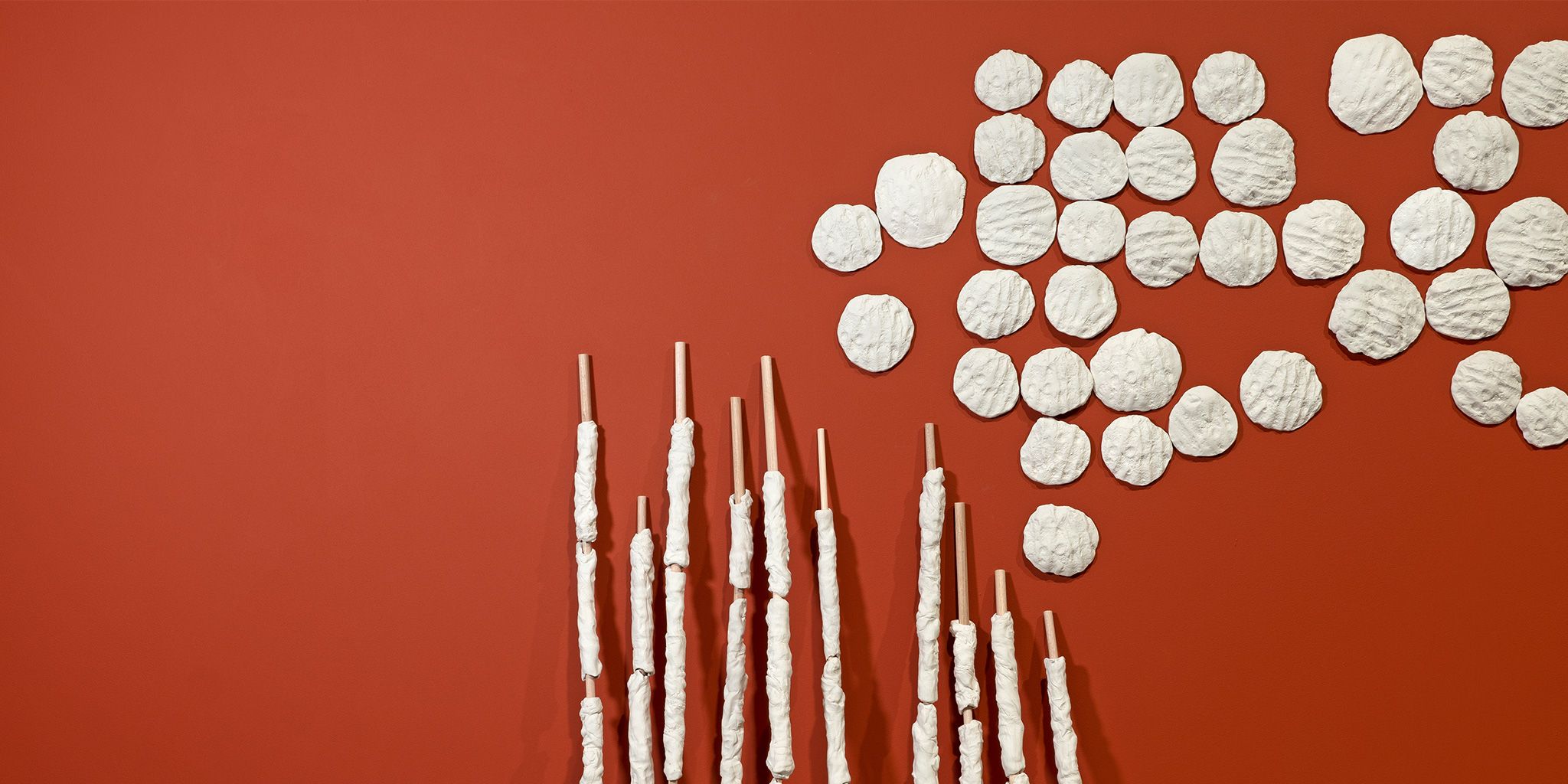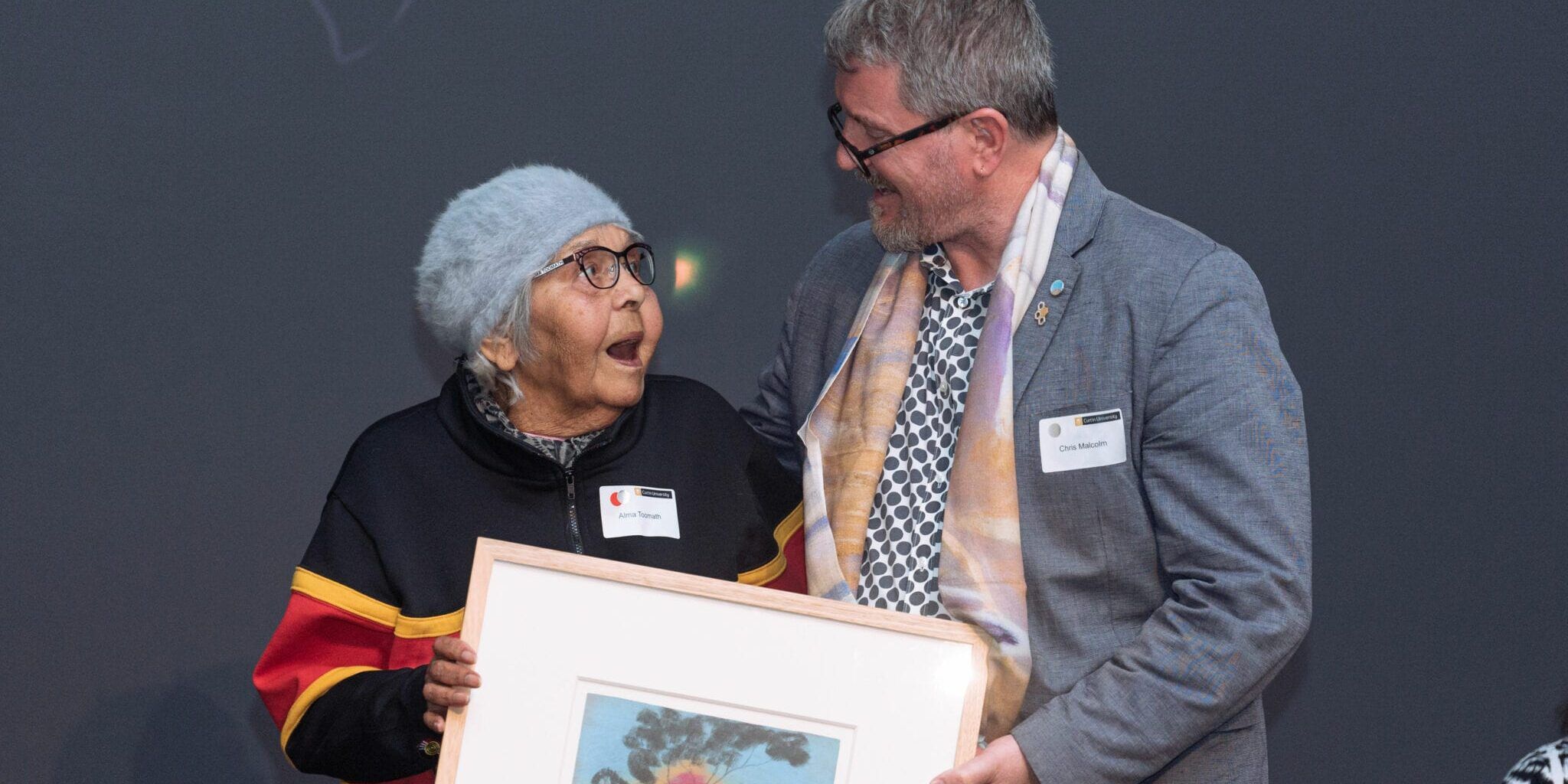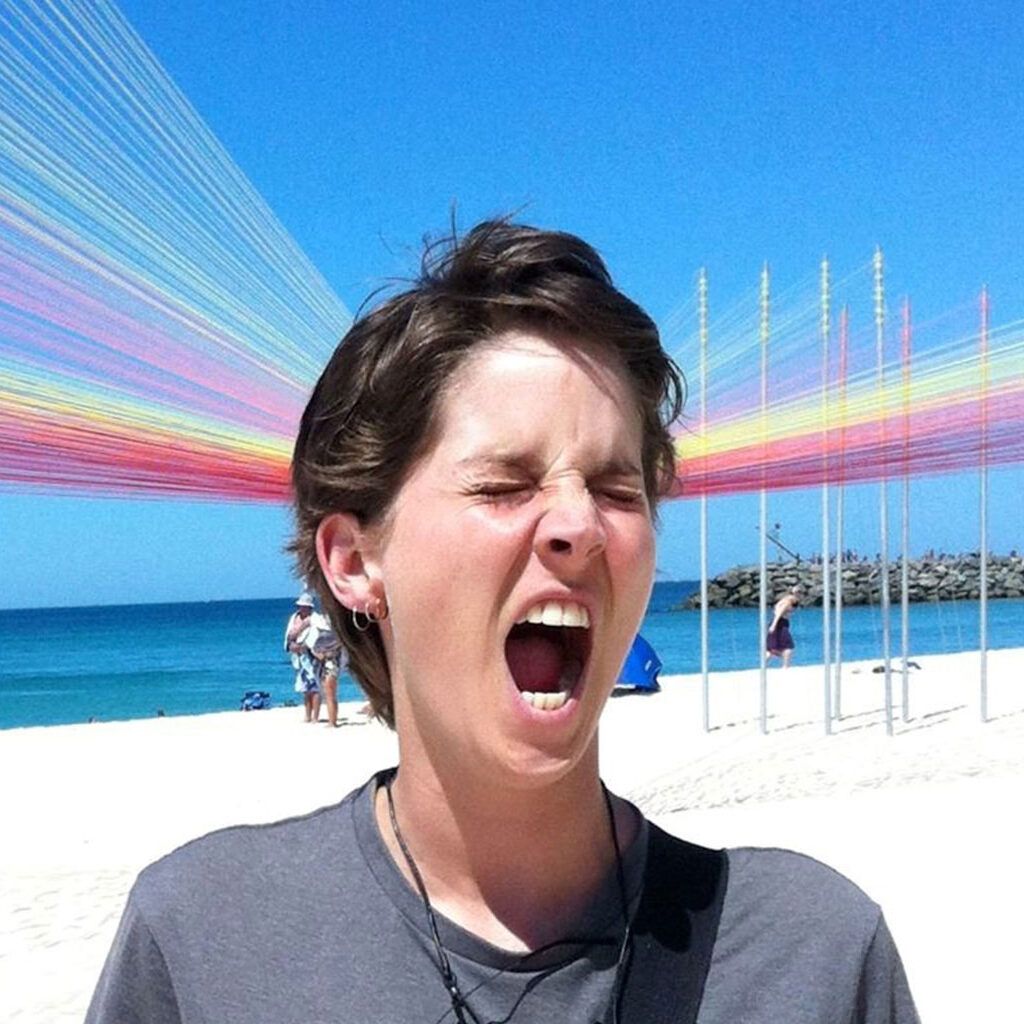Art + activism at the John Curtin Gallery
23/11/2021. By Arianne Chavez.

Madhivi Subrahmaniam, ‘Upla (Cow Dung)’, 2021, installation view, JCG, 2021. Photo by Sue-Lyn Moyle.
At the southern end of Curtin’s sprawling Perth Campus nestles the John Curtin Gallery, a welcoming, contemporary space that features some of the most thought-provoking exhibitions in the state of Western Australia.
The visual arts and social justice movements at the Gallery are inextricably intertwined. Art throws the world’s injustices into sharp relief – educating, provoking and effecting change. The Gallery has a proud history of examining complex social justice issues through art and encouraging robust discussion and the exchange of ideas.
The Gallery recently presented the Indian Ocean Craft Triennial, which featured artists, makers and crafted works from a selection of countries from around the Indian Ocean Rim. Curtin Commons profiles a selection of these artists whose activism is integral to their artistic practice.
Monique Tippett: KARRAKIN

Monique Tippett, ‘Pire & Karrakin 1 – 5’, 2021, installation view, JCG, 2021. Photo by Robert Frith Acorn Studio.

Artist Monique Tippett for IOTA21.
Displacement. Environmental damage. Climate change.
These are the themes that underpin Western Australian artist Monique Tippett’s work, Karrakin. Monique’s work depicts the red-tailed black cockatoos in flight in an increasingly degraded habitat, which is represented by a blackened pyre constructed from reclaimed railway sleepers from the local forest.

Monique Tippett, ‘Karrakin Four’, 2021, installation view, JCG, 2021. Photo by Sue-Lyn Moyle.
Monique’s art explores her relationship with the jarrah forest that surrounds her home, one of only thirty-five worldwide biodiversity hotspots. The area is threatened by bauxite mining, which is impacting the local ecosystem. In her work, Monique aims to convey the fragility of the environment in the face of man-made threats.
Melissa Cameron: JUUKAN TEARS

Melissa Cameron, ‘Juuken Tears’, 2021, installation view, JCG, 2021. Photo by Robert Frith Acorn Studio.
The Juukan Shelters in Western Australia’s remote Pilbara region were home to sacred caves used by traditional custodians, the Puutu Kunti Kurrama and Pinikura peoples, for more than 46,000 years. In May 2020, mining company Rio Tinto, in pursuit of high-grade iron ore, blew them up. The company was condemned by First Nations peoples, the federal government and the public.

Melissa Cameron, ‘Juuken Tears’, 2021, installation view, JCG, 2021. Photo by Robert Frith Acorn Studio.
Perth-based Melissa Cameron, who creates socially aware/protest art, spent nine months making Juukan Tears, a response to the destruction of the sacred site and the silencing of First Nations people. The artwork depicts the capital’s tallest building, the Rio Tinto office tower (also known as Central Park), drawn in linked panels of galvanised iron, hand-cut from her backyard shed.
The accompanying piece comprises chains of 4,600 teardrop shapes, each one representing a decade of the 46,000 years of history that were lost when the Juukan Shelters were destroyed.
Madhivi Subrahmanian: UPLA

Madhivi Subrahmaniam, ‘Upla (Cow Dung)’, 2021, installation view, JCG, 2021. Photo by Sue-Lyn Moyle.
Many women of rural India live unseen lives. Singaporean-based artist Madhvi Subrahmanian pays homage to these women in her work, Upla. Their daily work is simple, repetitive and often overlooked, but critical to the effective running of the homes and families in the villages. Every day, they make upla, or cow dung pats, an essential fuel for cooking and to provide warmth. They also spread dung, a natural antiseptic and insect repellent, across floors in homes.
In this artwork, Madhvi has constructed upla from pristine porcelain. Unlike the upla made from cow dung, and used daily, she has immortalised the handprint of an unknown village woman; a recognition of her important role. And while porcelain is considered a precious material, upla are not. Madhvi explores this contradiction in her work, emphasizing that the valuable porcelain she works with contributes far less to daily life than the humble upla.
Jan Griffiths: HISTORY BENEATH THE BEAUTY

Jan Griffiths, ‘History Beneath the Beauty 3’, 2021, installation view, JCG, 2021. Photo by Sue-Lyn Moyle.
Jan Griffiths is a Miriwoong/Ngarinyman woman living in the remote Kimberley region of Western Australia. Daughter of renowned artists Peggy and Alan Griffiths, Jan began painting to continue the cultural stories handed down to her.


Jan Griffiths creating the Billabong installation.
Jan Griffiths in front of her father’s painting.
Jan’s art tells the story of her grandmother as a girl, who escaped on horseback from an Aboriginal tracker and a station manager, who were looking for workers for one of the stations. The young girl ran to the local billabong, where she often collected flowers and edible bush food, and hid under the cool, green lily leaves until the strange men had passed.
Athi-Patra Ruga: THE PROPOSED MODEL OF THE NEW AZANIAN
Athi-Patra Ruga critiques the political and social climate of post-apartheid South Africa through his art. He creates myths and alternative realities to view historical trauma from the perspective of detachment.
In his artwork of an idealised vision of the model Azanian [South African] citizen, Athi-Patra draws on the visual authority of the Hellenic tradition, but subverts it with non-binary athleticism, highlighting the danger of deifying figureheads and the impossibility of utopias.

Artist Athi-Patra Ruga.
Garry Sibosado: OONGOONORR
Garry Sibosado is a saltwater man from the Bard Country in the Dampier Peninsula, and a master craftsman of Riji, the carved mother of pearl shell (guan) used for ceremony, trade and adornment. His art is a powerful reflection of his heritage.

Gary Sibosado, ‘Oongoonorr’, 2021, installation view, JCG, 2021, Photo by Robert Frith Acorn Studio.

Artist Gary Sibosado.
Oongoonorr, also known as the Milky Way, contains many cultural symbols including totems, and stories about the stars which are passed down from generation to generation. Oongoonorr is comprised of 220 pieces collected from land and sea; its design based on traditional stories from Bard ancestors.
Tjanpi Desert Weavers: TUTJURANGARA MASSACRE (CIRCUS WATERS ROCK HOLE MASSACRE)

Nancy Jackson and Judith Yinyika Chambers, ‘Tutjurangara Massacre (Circus Waters Rockhole Massacre)’ 2018, installation view, JCG, 2021, Photo by Sue-Lyn Moyle.
Judith Yinyika Chambers is a Ngaanyatjarra woman who lives in the remote community of Warakurna in Western Australia. Her mother was artist Carol Maatja Golding. Nancy Nyanyana Jackson is a well-regarded artist who belongs to the Ngaanyatjarra language and cultural group.
Nancy and Judith’s collaborative work tells the story of a little-known massacre, involving their relatives, which happened at Tutjurangara (Circus Water) prior to 1935. There is no written record of the atrocity, however the story of the massacre has been passed down verbally among the Ngaanyatjarra cultural group. With their art, Judith and Nancy hope to increase awareness of this brutal event.

Artist Nancy Jackson.
___
Explore more information featured in this article

Support the John Curtin Gallery
The mission of the John Curtin Gallery is to bring to its audiences, both within Curtin University and well beyond, opportunities to experience and critically engage with the visual culture of our time. If you would like to support the Gallery, donate to their Support Fund below.

Connect with the Humanities
Through the humanities, we learn about the world around us, ethics, human rights and issues that relate to and challenge our own beliefs, values and assumptions. Find out more about our Humanities community.


